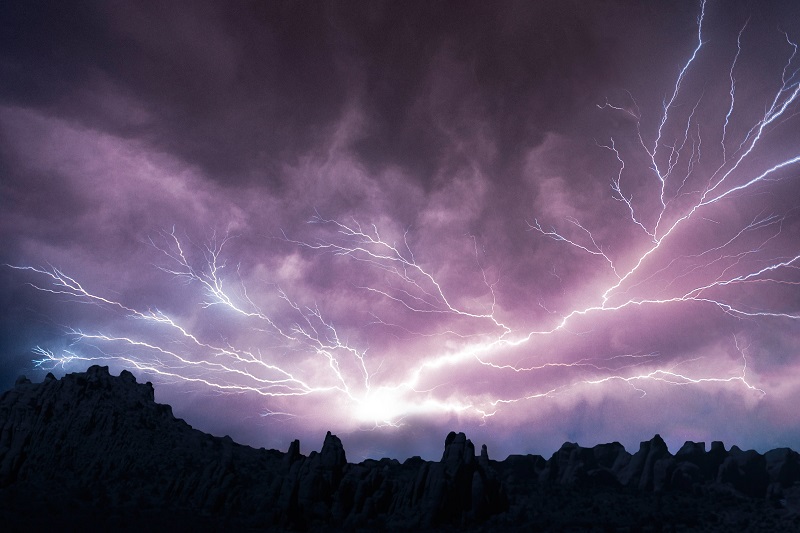
Will there be a rise in lightning-related deaths in India as the climate changes?
Gurwaith village residents in Indian Kashmir used to not be afraid of thunderstorms, but in recent weeks, people have hurried home or stayed inside at the sight of dark clouds in the sky.
On May 6, lightning struck a village and killed four people—two sheepherders and a couple working on their farm—marking the area’s first fatal storm as climate change increases the likelihood of more frequent strikes throughout India.
Following the incident in May, “people are scared,” claimed Saif-u-Din Dinda, a farmer in the village of Budgam district. When the weather gets bad, “everyone rushes home.”Khadija Begam, a fellow villager, recalled how she and her husband Mohammad Sultan Chopan “used to get caught in thunderstorms while herding our sheep.” Mohammad Sultan Chopan was one of the four victims.
But lightning has never killed anyone, she argued.
According to India’s National Disaster Management Authority (NDMA), thunderstorms and lightning have become significant weather hazards in recent years, killing about 2,500 people annually. Those living in rural areas or doing outdoor work are most at risk.
According to the most recent data from the National Crime Records Bureau (NCRB), among “forces of nature” — which also include avalanches, cyclones, and landslides — lightning is the deadliest, accounting for 40% of the 7,126 such deaths in 2021.
Keep Reading
Lightning strikes are becoming more frequent not only in India but also in countries like Nepal, Brazil, and the United States as temperatures rise and droughts get worse across the globe.
More intense heat can increase the amount of moisture in the atmosphere and promote a swift updraft, which are essential conditions for the charged particles that cause lightning.
Longer dry intervals between bursts of torrential rain are making lightning strikes more frequent in India, where lightning is common during the rainy season.
According to Sunil Pawar, a scientist at the Indian Institute of Tropical Meteorology (IITM) in Pune, the frequency has increased by 20% to 35% in various parts of India since 2019 as a result of climate change and worsening air pollution.
According to Pawar, “Lightning strikes are also expected to increase further as climate change is expected to bring about more heatwaves in the upcoming years.”
Between April 2020 and March 2021, there were 18.5 million lightning strikes, a 34% increase from the previous year, according to a 2021 report by the Lightning Resilient India Campaign (LRIC).
According to officials, the government has made investments in detection sensors and developed a mobile app to provide area-specific information about lightning strikes. However, experts like Sanjay Srivastava of the LRIC are urging for more to be done to increase awareness and protect the general public.
Farmers, herders, fishermen, and students in rural schools continue to be our greatest challenges, according to Srivastava, convener of the LRIC, a joint initiative of numerous organizations and governmental bodies, including the NDMA and the Indian Meteorological Department.
Increasing awareness as the risk of lightning rises
Climate scientists from all over the world are raising the alarm about the possibility that global warming will cause lightning strikes to occur more frequently and the potential effects this could have on related disasters like forest fires.
As an illustration, Canada is receiving attention as it prepares for its worst-ever wildfire season. This year, at least 3.3 million hectares (8.2 million acres) have burned, with Quebec province suffering the most as a result of numerous lightning-sparked fires.
According to a 2021 study that appeared in the journal “Atmospheric Chemistry and Physics,” lightning frequency in India is predicted to increase by 10% to 25% by the end of the century, while its intensity is predicted to rise by 15% to 50%.
According to experts, India experiences a significantly higher rate of lightning-related fatalities than developed nations.
According to research conducted in 2016 and published by Vaisala, a Finnish weather and environmental products company, approximately two people per million die from lightning each year in India, but this number is only 0.1 per million in the US and Australia, for instance.
According to Rohit Chakraborty of the Divecha Centre for Climate Change, a research institute, India should follow the US’s lead, where safety campaigns, easily accessible weather information, and research into the causes of lightning casualties have significantly reduced the number of deaths in recent decades.
He continued that the country must consider how its expansion and development are aggravating the fundamental causes of extreme weather.
Chakraborty stated that to develop, “India and other developing countries, which are rapidly building infrastructure and urban areas in addition to more transportation and industries, must also adopt clean (carbon-free) development models.”
This will be the most effective way to address heat generation or climate change, which is increasing the frequency of natural disasters related to lightning.
According to Srivastava of the LRIC, fewer people will be killed by lightning in India this year as a result of steps taken by some states, including Andhra Pradesh, Odisha, and Jharkhand. He cited better forecasting, lightning sensors, and shelters.
Srivastava, who is also a member of the National Panel of Experts on Lightning at India’s NDMA, stated that their main goal is to raise awareness among the public about the fact that the best defense against lightning is to stay indoors during lightning.
Ashfaq Ahmad Chopan, whose mother perished in the May lighting strikes, claimed that the Gurwaith village community could not afford to stay inside each time the skies turned ominous.
People should be aware of such danger to save lives.




